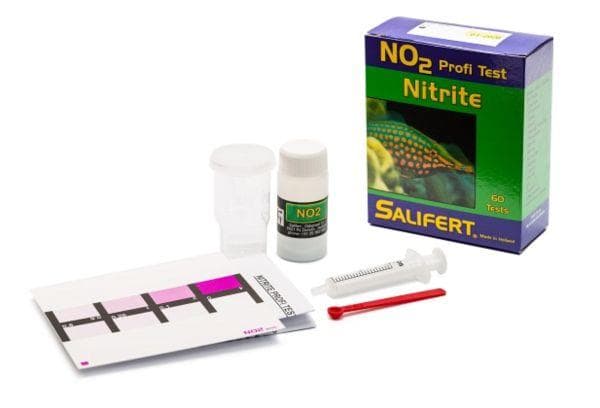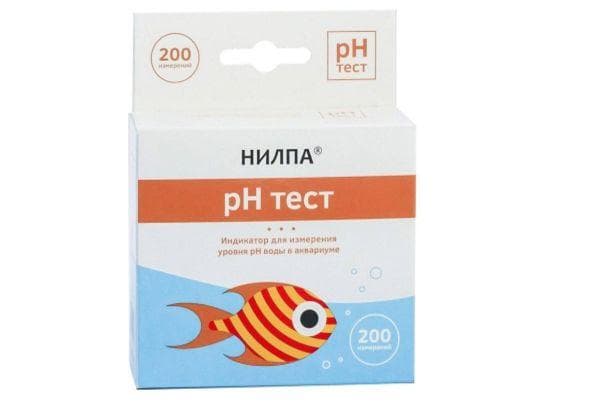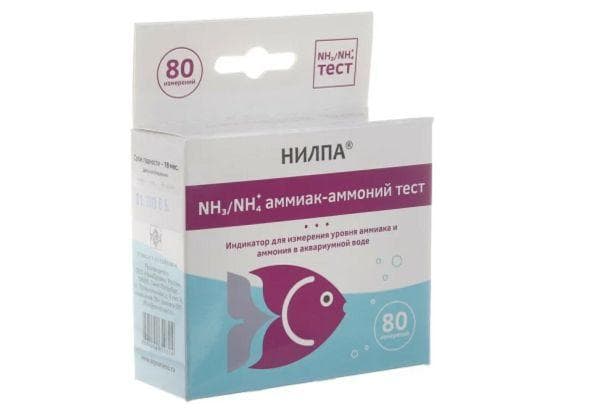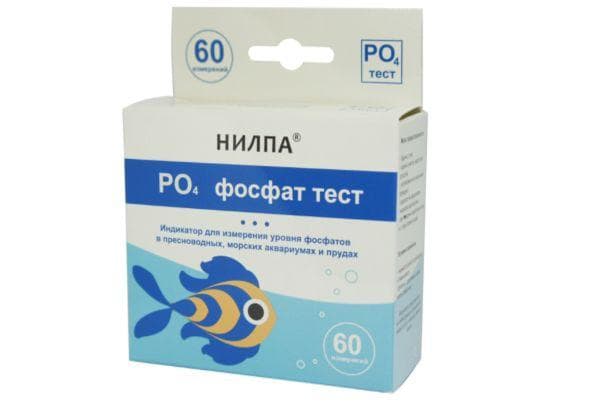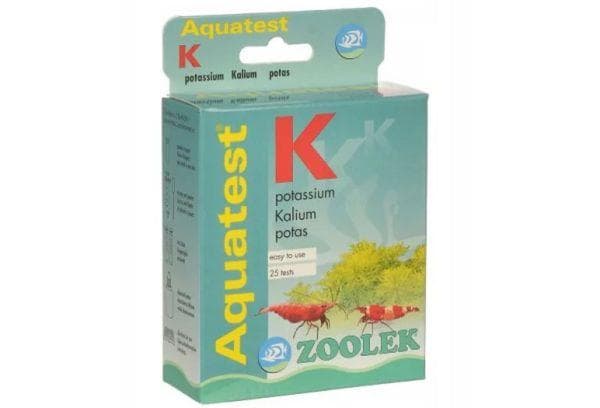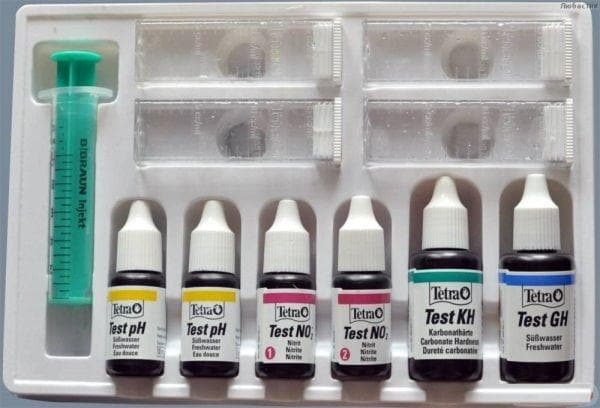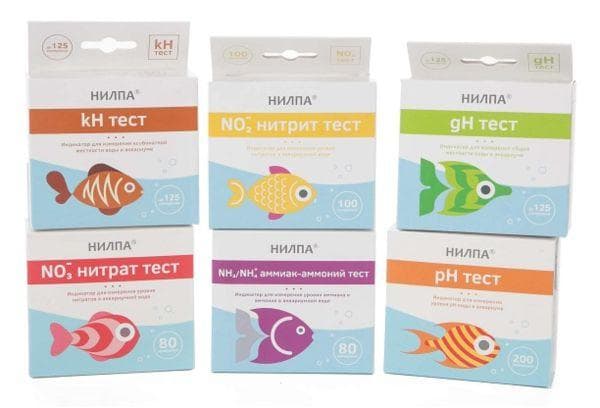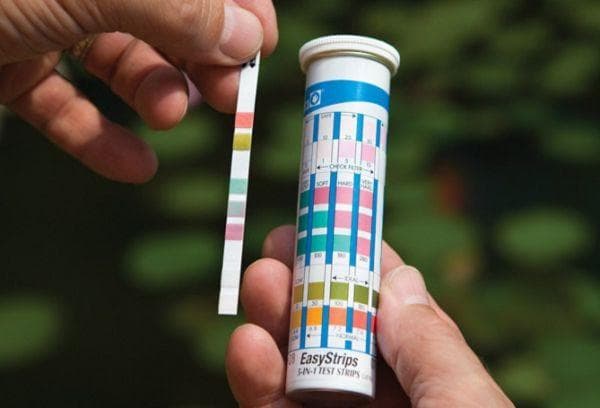How and why to test water in an aquarium
Content:
Tests for water in an aquarium make the life of an aquarist much easier, because the parameters of the aquatic environment directly affect the life of underwater inhabitants. In order for the fish to remain healthy, it is necessary to maintain a certain chemical balance, and without regular monitoring this is impossible.
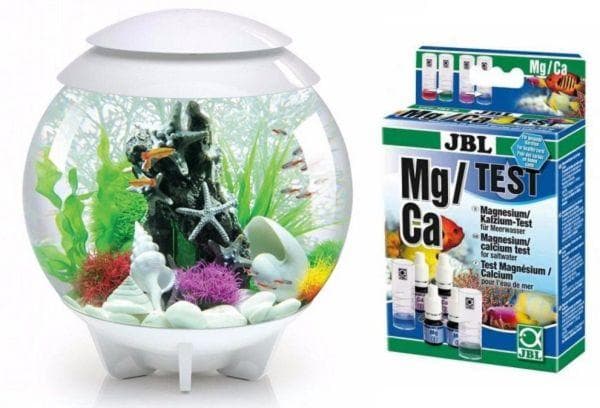
What parameters should be regularly measured in an aquarium?
The main problem of aquariums is considered to be exceeding the maximum permissible concentration of nitrates. At the same time, some other parameters that affect the health and life expectancy of fish cannot be ignored. With a responsible approach to his favorite hobby, the aquarist should conduct testing weekly. Once an imbalance is identified, it can be eliminated by using mono-solutions and carrying out more frequent water changes.
Test for nitrates in an aquarium
One of the most important parameters measured is the amount of nitrates. These compounds are formed during the life of nitrifying bacteria that process ammonia released by fish feces. The amount of organic matter released depends on the population of the aquarium and decreases during regular bottom cleaning.
For most aquarium inhabitants, the optimal nitrate level will be within 20-30 mg/l, and for sensitive fish the numbers should be another 5-10 units lower (15-20 mg/l). You can test water for this parameter using test strips, drop tests,
pH test for aquarium
A pH test is used to determine the acidity level of aquarium water. An indicator less than 7 units indicates that the water is acidic. If the pH is above 7, then the environment is alkaline. It is considered normal if the acidity level is in the range of 5-10 pH. Sharp fluctuations in this parameter in one direction or another should not be allowed - this can lead to the death of fish.
If the pH exceeds 7.2, many microelements become unavailable to aquarium plants, and their absorption of carbon dioxide becomes difficult. Excess light, strong aeration, and the release of minerals from the soil or decor can increase the acidity level. To measure pH, test strips, a pH meter, a pH controller, and a drop test are used.
Ammonia test in aquarium
Ammonia is a waste product of fish, released through their kidneys and gills. This substance is poisonous and can lead to serious poisoning and death of aquatic pets. Nitrifying bacteria living in the soil and on the filter sponge convert ammonia into nitrites, which are safer for fish, but do not always cope with this task completely. Signs of ammonia poisoning:
- color change;
- the appearance of mucus on the scales;
- hemorrhages near the fins;
- rapid breathing;
- loss of appetite;
- inactivity.
If at least one of the symptoms appears, you must immediately do a test for the ammonia content in the water (sometimes the substance is present in the form of ammonium).Testing is carried out using a drop test and shelves of paper soaked in a reagent.
Test for phosphates in an aquarium
Phosphates, like nitrates, are part of the nutrient medium for aquarium flora. But plants cannot always process them in full. If there is too much phosphate in the aquarium, the walls begin to become covered with green algae, and the water also “blooms.” To prevent lower plants from invading the fish’s home, it is necessary to regularly test for phosphates. It is better to prevent a problem than to deal with it later. Phosphates are measured using drop and powder reagents.
Test for potassium in an aquarium
Potassium is one of those elements whose content in a freshwater aquarium does not affect the condition of fish, but can affect the life of aquarium plants. It is especially desirable to control this parameter in the herbalist. In a saltwater aquarium, the need to test for potassium increases, as too much potassium can kill sensitive fish such as shrimp.
If there is a lack of potassium in fresh water, a specialized fertilizer from JBL is applied. Excess of this element in a marine aquarium is eliminated by partial water changes. The test is carried out using liquid reagents (drip).
Saltwater Aquarium Tests
For those who have just started setting up a marine aquarium, it is important to know what parameters you should pay attention to first. This:
- NH3 – ammonia content;
- pH – pH value;
- kH – carbonate hardness;
- Ca – calcium content;
- NO3 – nitrate level;
- PO4 – phosphate content.
Aquarists use drop tests to determine the composition of water in a saltwater aquarium.A more expensive laboratory method is used by those who are involved in professional aquarium farming.
Drip tests for aquariums
The best manufacturers (Tetra, JBL, API, UHE) offer a set of tests to determine various indicators of aquarium water. With their help, it is possible to most fully determine the content of impurities in the aquatic environment and how safe it is for its inhabitants. For example, drop tests from Tetra include 6 bottles in a set that allow you to measure the content:
- oxygen;
- gland;
- phosphates;
- nitrites.
Two more bottles are designed for measuring total and carbonate hardness. The reagent is dripped from the bottle into a measured portion of water, which is immediately colored. The result must be compared with the color scale.
Nilpa tests for aquariums
Drip tests are now produced by a Russian manufacturer under the Nilpa trademark, produced by the Aqua Menu Group of Companies. Using reagents, you can test water for:
- gland;
- copper;
- nitrates;
- phosphates;
- ammonia.
Tests are also produced to indicate the level of total and carbonate hardness and water acidity. Nilpa also produces all the necessary reagents to maintain the required chemical balance, as well as air conditioners.
Test strips for aquarium
Test strips are made of paper impregnated with chemical reagents. They are very easy to use. The strip is dipped into water, after which it turns a certain color. The shade should be compared with the supplied color chart. Test strips are convenient because they are sold individually. However, the obtained data may have a large measurement error.
Electronic tests for aquarium
Electronic tests are more accurate than other testing methods. This device is equipped with a probe, which is immersed in water at the time of measurement. The result is displayed digitally on an electronic display. The most common in this category is the pH toaster. It can be ordered at an inexpensive price on Aliexpress and used after preliminary calibration by testing the indicator liquid.
Even if aquarium water appears crystal clear, its composition may be far from ideal. Regular testing will provide an understanding of the processes occurring in the aquatic system and the ability to adjust parameters so that the aquatic environment always remains safe for the inhabitants of the aquarium.
